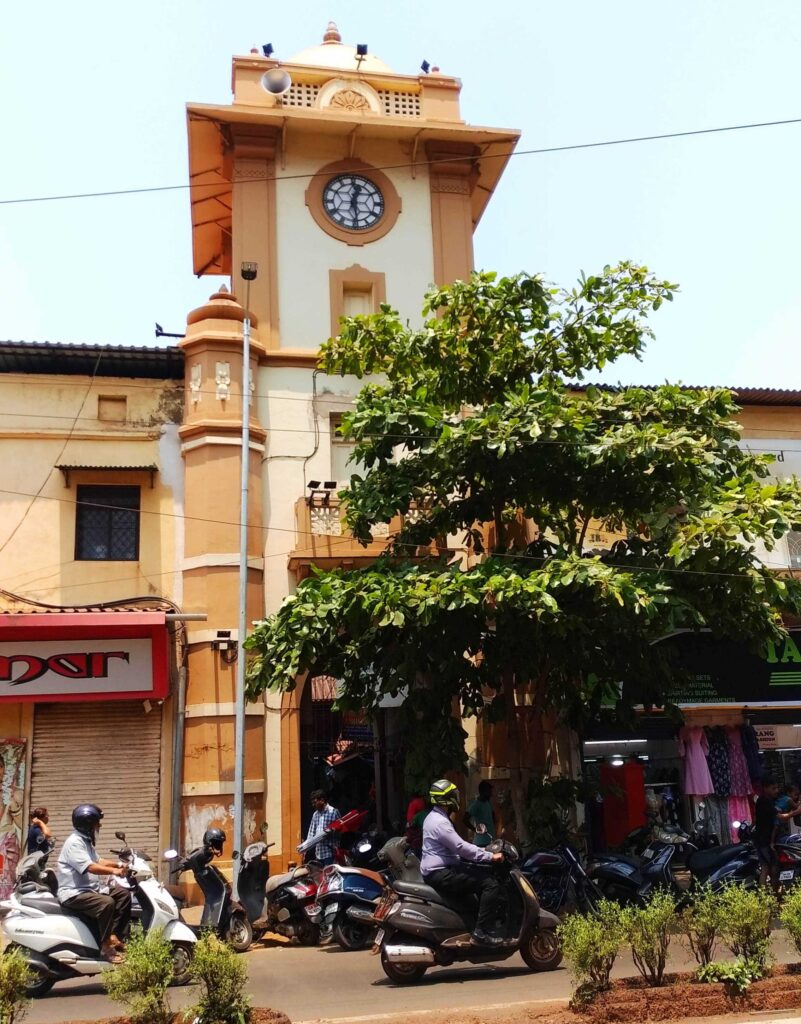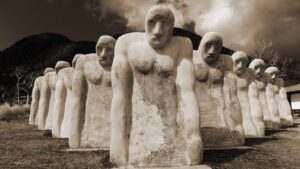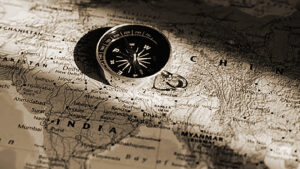Vasco da Gama city and India’s colonial hangover
May 15, 2024: The date is 1st October, 1502. A European pirate captures a passenger ship called Meri in the middle of the Arabian Sea. On board the wooden ship, there are hundreds of pilgrims who are returning from Saudi Arabia to India’s Malabar coast.
The European pirate holds the Meri hostage for five long days. He seizes 12,000 ‘ducats’ or gold coins. He’s not done yet. He orders his men to burn all 700 passengers alive on board the vessel. Half of the passengers are women and children.
Following their boss’s orders, the band of pirates set the wooden ship on fire. They ensure that it burns for two long days. After being set on fire, as the ship slowly goes up in flames, desperate screams and cries for help are heard from far, far away. The women passengers on board hold their babies up, asking the pirates to show mercy as the fire ominously approaches them.
Some mothers panic and throw their babies into the unforgiving waters of the Arabian Sea, hoping that they will survive the ordeal on board. The cold-blooded pirate leader, meanwhile, watches the fiery massacre unfold from a distance, as 700 people slowly get roasted to death.
This blood-curdling episode is later documented as the pilgrim ship incident.
The name of the European pirate behind this awfully criminal act is none other than Vasco da Gama, a decorated hero of the so-called Age of Discovery (read: Age of European Plunder). He is celebrated by the Western world and many Indian historians as an iconic Portuguese explorer.
Welcome to Vasco da Gama city
Vasco da Gama was the first European criminal to invade Indian territory. His arrival opened the floodgates for European bandits and settlers to colonise the Indian peninsula for the next 500 years.
Today, in the beautiful western Indian state of Goa, an entire city is dedicated to this Portuguese mass murderer. The city is officially called Vasco da Gama. Most people don’t complain about it. Most people don’t want the name changed, barring a few exceptions, who have tried to get Vasco da Gama city permanently renamed ‘Sambhaji Nagar’.

Located in western Goa, Vasco city lies near the Dabolim airport and juts out into the Arabian Sea. It is a wonder of modern India that a city officially exists in the name of a man who had launched India’s invasion by the West. There is a lot of noise in India these days about changing Mughal-era names of cities. But it is largely politicised. No one questions why an Indian city should continue to be called Vasco da Gama.
To understand why it is humiliating and shameful for Indians to have a city in Vasco’s name, you have to do things. One, you have to look at the dirty track record of the Portuguese pirate. And two, you have to look at the dark history of colonial-era Goa, when Portuguese colonisers treated Indians with extreme cruelty, brutality, and disdain.
The city of Vasco da Gama was established in 1543 during the height of the Portuguese colonial empire in India, which they called ‘State of India’ at that time. At that time, Portuguese colonisers had a firm grip on the population of the entire Malabar coastline.
A tainted railway station
Interestingly, despite a simmering rivalry between Portuguese and British colonisers at that time, Portuguese-controlled Vasco city’s main railway station was built in coordination with British colonisers in India. Vasco was so admired by the Europeans that the train depot was named ‘Vasco da Gama Railway Station’. The railway station is located on Swatantra Path in Vasco city. The dark irony is that Swatantra Path means ‘freedom road’.

Vasco da Gama Railway Station is today owned by Indian Railways and operated by its South Western Railway Division. For passenger trains, Vasco station is a terminus. From there, the railway track goes all the way eastwards to Guntakal town in Andhra Pradesh, crossing the Western Ghats. The line is called Mormugao Railway.
Isn’t it incredible and atrocious that the Indian government uses taxpayer money to run a railway station named after a racist pirate who once killed thousands of Indians out of hatred?
There is another landmark in Vasco city that stands out as a symbol of the Portuguese bandit. It’s the Vasco Clock Tower, which also lies on Swatantra Path, close to Vasco da Gama Railway Station. The clock tower, built in 1935, is located in the busy Municipal Market area. Nobody questions why the city’s most prominent landmark is named after a coloniser. Instead, a local charitable trust has taken charge of restoring and maintaining the Vasco Clock Tower.

Vasco city is dotted with many more landmarks named after him. There is Vasco Sports Club in the northern part of the city. The football club was created in 1951 by Portuguese soldiers who were deployed in Goa at that time to defend Portuguese-occupied India. Then there are many malls, shops, houses, and statues dedicated to him.
Colonial hangover
About 500 years ago, Vasco da Gama set foot on Indian soil and unleashed unprecedented misery and murders. Then in 1961, the Indian government – 14 years after attaining independence – took back control of Goa from Portuguese colonisers and chased them out.
Fast forward to 2024. Why do we still have an entire city named after the Portuguese pirate? Is there a colonial hangover that we Indians, especially Goans, are unable to shake off?
Let’s turn the clock back to how India’s nightmare relationship with the man started. On 20th May, 1498, Vasco da Gama and his fleet of four ships sailed from Portugal, circled around Africa from the south, and arrived at Kappadu, near modern-day Kozhikode in southwest India. The Europeans called it ‘Calicut’ at that time.
Vasco’s long and winding predatory journey was funded by Portugal’s king on the orders of the Pope in Rome, who headed the Vatican church network. The mission was to colonise Indian territory, control its resources, torture its people, and impose Catholicism.
The spineless king
In an act of cowardice and lack of dignity, the ruler of the Samoothiri kingdom in Kozhikode at that time welcomed Vasco and his men with open arms. Instead of being captured and questioned, the pirate leader received a hero’s welcome in Kozhikode. Vasco was given a lavish parade by 3,000 men under the Indian king.
In the months, years, and decades that followed, Vasco and his Portuguese successors captured the Malabar civilisation and turned its people into targets of persecution, murder, slavery, and exploitation.
Just like the ‘pilgrim ship incident’, yet another episode stands out as testimony to Portuguese atrocities in India. On 27th October, 1502, Vasco da Gama captured 50 Malabari sailors. He got his men to chop all 50 captured Indians into pieces. Vasco then got his men to put the chopped body parts onto a boat, and sent it to the Samoothiri king. He planted on the boat a written message for the Indian king. Vasco wrote: “Here is a small gift. You can cook curry out of these body parts and eat it.”
There are many other things that Vasco did on Indian soil for which he should have been hanged. Instead, he was made Viceroy of Portuguese-occupied India. Back home in Portugal, he was appointed Count of Vidigueira, and he wined and dined with aristocrats.
On orders from the Pope and the Portuguese king, Vasco asked his men to perpetually harass Indians who practised Hinduism, Islam, Buddhism, and other religions. He had orders from Europe’s Catholic church network to carry out forced conversions.
In a very, very dark way, Vasco actually brought India’s Hindus and Muslims together by brutally targeting them both. He also burnt down many Indian villages. His men had this horrible practice of not just killing Indians, but also chopping their heads and hanging them at the door as a warning sign for other dissident Indians.
Vasco da Gama died in Kochi – named ‘Cochin’ at that time – from an illness on 24th December, 1524, at the age of 64. He was buried at St. Francis Church in the neighbourhood of Fort Kochi, called ‘Fort Cochin’ at that time. Fourteen years later, his remains were taken to Portugal, where he is remembered as a heroic explorer and founder of the Portuguese empire in India.
Inquisition or perversion?
The point is, it’s understandable for selfish Europe to celebrate the Portuguese coloniser. That’s what Europe has done for centuries – turning crooks, pirates, thieves, rogues, cheats, bandits, looters, racists, rapists, murderers, fraudster, and dacoits into legends and statues. But why does India have a city officially named after this man? And also, why Goa?
The question of ‘why Goa’ is important here. That’s because of something called the Goa Inquisition. It is another filthy chapter from Portuguese colonial misrule over Malabar India.
Goa was invaded by Portuguese pirates in 1510. It happened under Vasco da Gama’s successor, Afonso de Albuquerque. The invader Albuquerque was an equally dangerous man, if not worse than Vasco. His men took control of Goa from the hands of the local Adil Shahi kingdom. After that, he set up Goa for the inquisition that came into effect soon after he personally left the scene.
So, what’s this inquisition that the people of Goa suffered? It was basically a dirty project approved by the Pope, higher-ups in the Catholic church network, and the king of Portugal. It was a project to unleash religious terror across Goa. The mission was to wipe out all religions from Goa, and establish Catholic Christianity. The wipeout involved force and brutality never seen before.
Many people don’t know that it was Francis Xavier who advised the Portuguese king to impose a witch-hunt in India in the name of inquisition. Francis Xavier was a Spanish missionary who also worked for the Portuguese empire. Today, he is celebrated in the West as a saint. But he was the one who got the Goa inquisition started.
If you closely look at what really happened during the Goa inquisition, you’ll realise why it is shameful for India to dedicate a city to Vasco. The inquisition in Goa went on from 1560 to 1812. During this period, Portuguese men officially killed 57 Indians – and many more unofficially – for trying to defy the religious witch-hunt.
All domestic religions were branded as witchcraft, and therefore, declared illegal. Portuguese invaders also banned Konkani and Sanskrit languages. More than 16,000 local people were charged for protesting against the inquisition. In one gruesome episode, when 64 protesting Indians died in a jail in Goa, their bodies were dragged out in the open and burnt in full public glare.
Strange and scary laws were brought in. If a Hindu man died, his children were forcefully captured by the Portuguese men. Hindu marriages and rituals were also declared illegal. A new tax, called ‘Xenddi’, was imposed on Indians who chose not to follow Catholicism. It was imposed in Goa, Daman, and Diu.
At least 1,000 temples were vandalised or burnt down by Portuguese men. It is said that many worshippers died inside the temples when they were attacked. Temples were mostly taken down in Bardez and Salcete. Takedowns also happened on Divar island.
The inquisition was so terrifying that out of Goa’s population of 2.5 lakh people, hardly 20,000 Indians protested and defied it. The majority surrendered to the Portuguese demand and converted to Catholicism in order to escape persecution and death.
Evidence torn up
Once the inquisition was called off in 1812 due to social pressure, Portuguese occupiers cleverly tore up all the evidence into bits and pieces. As a result, due to lack of proof, no one today knows precisely how many people were tortured and killed during the inquisition. And there’s no longer any evidence left of inquisition-related orders and correspondence that came from time to time from the Pope in Rome and the king of Portugal.
Now, try to visualise this hypothetical scenario: an Indian man sails to Portugal. He and his men colonise the country. They burn down cities and towns, kill the men, rape the women, torture the children, ban local religions, colonise the place, and then one fine day, they leave the place.
What will the Portuguese people and the Portuguese government do? Will they honour this hypothetical Indian coloniser by naming an entire city after him? And a government-run railway station? And prominent landmarks? They will have to be out of their mind to do that.
But that’s precisely what we have done in India. Vasco da Gama’s notorious acts are well known to most Indians, including policymakers. Some critics believe Vasco and his successors together were responsible for killing a few lakh Indians in the Malabar region. And how have we Indians responded to that? We dedicated an entire city to him.
You can say that it is understandable if a railway station and a clock tower are named after him. All over India, many streets and landmarks are still named after British and French colonial invaders. But here, we are talking about an entire city named after Vasco da Gama – the man who launched Western imperialism in India.
Do we Indians really have a spine? Do we have a sense of self-respect? Ask these questions if you come to Goa and happen to visit the city of Vasco da Gama.
COPYRIGHT & REPUBLISHING TERMS:
All rights to this content are reserved with Empire Diaries. If you want to republish this content in any form, in part or in full, please contact us at writetoempirediaries@gmail.com.
ALSO READ…









